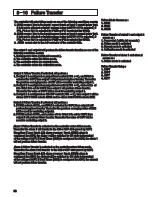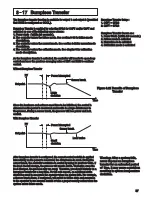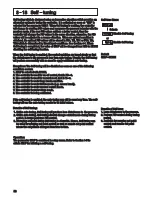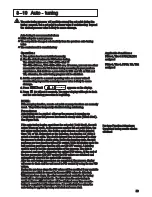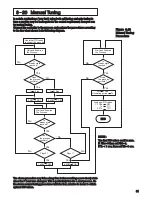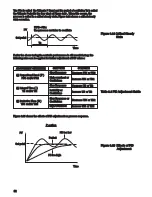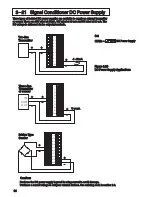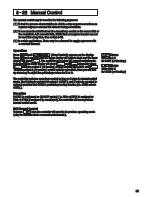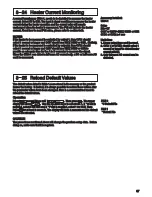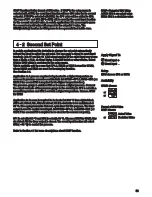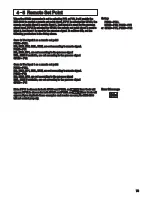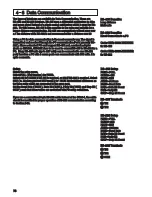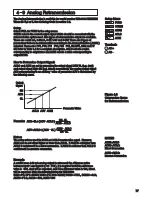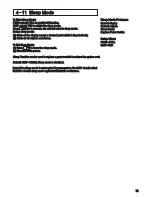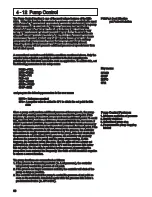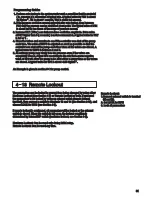
4 3 Second PID Set
4 3 Second PID Set
In certain applications the process characteristics are strongly related to the
ETR process value. The ETR-8300 provides two set of PID values. When the
process is changed to a different set point, the PID values can be switched to
another set to achieve an optimum condition.
In certain applications the process characteristics are strongly related to the
ETR process value. The ETR-8300 provides two set of PID values. When the
process is changed to a different set point, the PID values can be switched to
another set to achieve an optimum condition.
Event input +
Event input
Event input +
Event input
17
16
Apply Signal To
Apply Signal To
Setup
EIFN choose PID2 or SP.P2
EIFN choose PID2 or SP.P2
70
Choose
for
then both set point and PID values will be switched to
another set simultaneously. The signal applied to event input may come from
a Timer, a PLC, an Alarm Relay, a Manual Switch or other devices.
SP.P2
EIFN
Choose
for
then both set point and PID values will be switched to
another set simultaneously. The signal applied to event input may come from
a Timer, a PLC, an Alarm Relay, a Manual Switch or other devices.
SP.P2
EIFN
Application 1: Programmed by Set Point
Application 1: Programmed by Set Point
Application 2: Programmed by Process Value
Application 2: Programmed by Process Value
Auto-tuning Second PID
Auto-tuning Second PID
If the process value exceeds a certain limit, 500 °C for example, it is desirable
to use another PID values to optimize the control performance. You can use a
process high alarm to detect the limit of the process value. Choose PV1H for
A1FN, A1MD selects NORM, adjust A1SP to be equal to 500 °C, and choose
PID2 for EIFN. If the temperature is higher than 500 °C, then alarm 1 is
activated. The alarm 1 output is connected to event input, the PID values will
change from PB1, TI1 and TD1 to PB2, TI2 and TD2.
If the process value exceeds a certain limit, 500 °C for example, it is desirable
to use another PID values to optimize the control performance. You can use a
process high alarm to detect the limit of the process value. Choose PV1H for
A1FN, A1MD selects NORM, adjust A1SP to be equal to 500 °C, and choose
PID2 for EIFN. If the temperature is higher than 500 °C, then alarm 1 is
activated. The alarm 1 output is connected to event input, the PID values will
change from PB1, TI1 and TD1 to PB2, TI2 and TD2.
The optimal PID values for a process may vary with its process value and set
point. Hence if a process is used for a wide range of set point, dual PID values
are necessary to optimize the control performance. If the first PID set is
selected ( event input is not applied ) during an auto-tuning procedure, the
PID values will be stored in PB1, TI1 and TD1. Similarly, if the second PID set is
selected ( event input is applied while PID2 or SP.P2 is selected for EIFN )
during auto-tuning, the PID values will be stored in PB2, TI2 and TD2 as soon
as auto-tuning is completed.
The optimal PID values for a process may vary with its process value and set
point. Hence if a process is used for a wide range of set point, dual PID values
are necessary to optimize the control performance. If the first PID set is
selected ( event input is not applied ) during an auto-tuning procedure, the
PID values will be stored in PB1, TI1 and TD1. Similarly, if the second PID set is
selected ( event input is applied while PID2 or SP.P2 is selected for EIFN )
during auto-tuning, the PID values will be stored in PB2, TI2 and TD2 as soon
as auto-tuning is completed.
EIFN= SP.P2
EIFN= SP.P2
EIFN= PID2
EIFN= PID2
Alarm output Controls the Event
input
Alarm output Controls the Event
input
Refer to Section 5-9 for more details.
Refer to Section 5-9 for more details.
See Section 5-9
See Section 5-9

